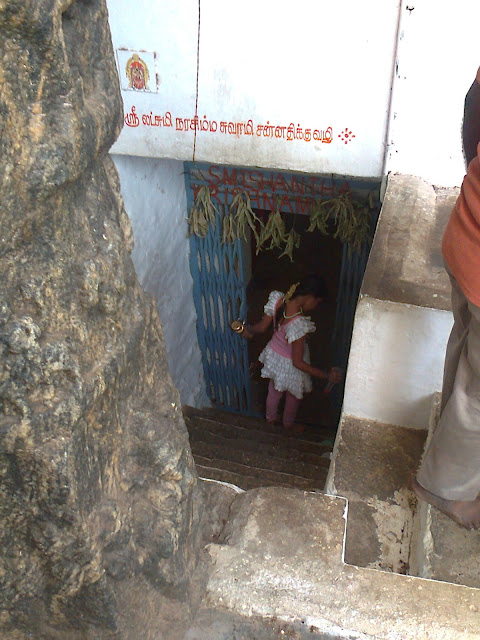Benefits of studying Bhagavad-Geeta
from
Skanda Purana
स्कन्दे अवन्ती खण्डे श्री व्यासोक्तौ
गीता सुगीता कर्तव्या अन्यैः शास्त्रविस्तरैः |
या स्वयं पद्मनाभस्य मुक्तपद्माद् विनिःसृता ||
या स्वयं पद्मनाभस्य मुक्तपद्माद् विनिःसृता ||
In the Skanda-purana, Srila Vyasadev says, “Memorize and sing sweetly this Bhagavad-gita. What need is there to elaborate on other scriptures? She has descended directly from the lotus mouth of Lord Padmanabh (Krishna).”
सर्वशास्त्रमयी गीता सर्वदेवमयी यतः |
सर्वधर्ममयी यस्मात् तस्मात् एतां समभ्यसेत् ||
The Bhagavad-gita contains the essence of all literatures. It is the sum total of all the demigods and the sum total of all religion. Therefore, one should study the Bhagavad-gita thoroughly.
शालग्रामशिलाग्रे तु गीताध्यायं पठेत् तु यः |
मन्वन्तरसहस्राणि वसते ब्रह्मणः पुरे ||
One who recites a chapter from the Bhagavad-gita in front of a shalagrama-shila resides for a thousand manvantaras in Lord Brahma’s abode.
हत्वा हत्वा जगत् सर्वं मुषित्वा सचराचरम् |
पापैर् न लिप्यते चैव गीताध्यायी कथञ्चन ||
One who reads the Bhagavad-gita is not touched by sin even by repeatedly killing or plundering the whole world with its moving and non-moving entities.
तेनेष्टं क्रतुभिः सर्वैर् दत्तं तेन गवायुतम् |
गीतां अभ्यस्यता नित्यं तेनाप्तं पदं अव्ययम् ||
Such a person attains the result of donating ten thousand cows and the result of conducting all Vedic sacrifices. Those who constantly study the Bhagavad-gita attain to the eternal spiritual world.
गीताध्यायं पठेद् यस् तु श्लोकं श्लोकार्धं एव वा |
भवपापविनिर्मुक्तो याति विष्णोः परं पदम् ||
By reading a chapter, a verse or even half a verse from the Bhagavad-gita, one is liberated from all sins and attains the topmost destination of Lord Vishnu’s (Krishna's) planets.
यो नित्यं विश्वरूपाख्यं अध्यायं पठति द्विजः |
विभूतिं देवदेवस्य तस्य पुण्यं वदाम्यहम् ||
A brahmin who studies the tenth and eleventh chapter of the Bhagavad-gita attains the following result [as described in the next verse].
वेदैर् अधीतैर् यत् पुण्यं सेतिहासैः पुरातनैः |
श्लोकेनैकेन तत् पुण्यं लभते नात्र संशयः ||
आब्रह्मस्तम्बपर्यन्तं जगत् तृप्तिं करोति सः |
विश्वरूपं सदाध्यायं विभूतिं च पठेत् तु यः ||
By studying a single verse from these two chapters one attains the same result as studying all the Vedas, Itihasas and Puranas (histories), of which there is no doubt. One who studies the tenth and eleventh chapters enjoys all pleasures enjoyed by all living entities - from the ordinary blades of grass up to Lord Brahma (Leader of demigods).
अहन्य अहनि यो मर्त्यो गीताध्यायं पठेत् तु वै |
द्वात्रिंशद् अपराधांस् तु क्षमते तस्य केशवः ||
Lord Keshava (Krishna) forgives all thirty-two kinds of offences for a mortal who recites a chapter of the Bhagavad-gita.
लिखित्वा वैष्णवानां च गीताशास्त्रं प्रयच्छति |
दिने दिने च यजते हरिं चात्र न संशयः ||
There is no doubt that those who copy and gift this literature to the devotees of the Lord attain the same result as worshipping Lord Hari (Krishna) daily.
चातुर्णां एव वेदानां सारं उद्धृत्य विष्णुना |
त्रैलोक्यस्योपकाराय गीताशास्त्रं प्रकाशितम् ||
For the benefit of the three worlds, Lord Vishnu (Krishna) has extracted the essence of the four Vedas and manifested that essence in the form of the literature known as Bhagavad-gita.
भारतामृतसर्वस्वं विष्णोर् वक्त्राद् विनिःश्रुतम् |
गीतागङ्गोदकं पीत्वा पुनैर् जन्म न विद्यते ||
Everything in the Mahabharata has emanated from the mouth of Lord Vishnu (Krishna). Those who drink the Ganges-like water of the Bhagavad-gita do not take birth again in the material world.
धर्मं चार्थं च कामं च मोक्षं चापीच्छता सदा |
श्रोतव्या पठनीया च गीता कृष्णमुखोद्गता ||
Those who desire religiosity, economic development, sense gratification, or liberation should always hear, study and sing the Bhagavad-gita, which has emanated from the mouth of Lord Krishna.
यो नरः पत्ते नित्यं गीता शास्त्रं दिने दिने |
विमुक्तः सर्वपापेभ्यो याति विष्णोः परं पदम् ||
The person who constantly reads the Bhagavad-gita day after day gets liberated from all sins and attains Lord Vishnu’s (Krishna's) abode.








